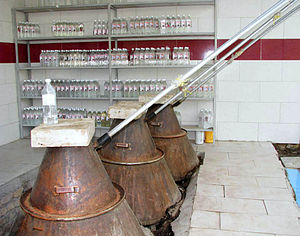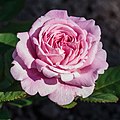Rose water

A small manufactory of rose water in Kashan, Iran
Rose water is a flavoured water made by steeping rose petals in water. Additionally, it is the hydrosol portion of the distillate of rose petals, a by-product of the production of rose oil for use in perfume. It is used to flavour food, as a component in some cosmetic and medical preparations, and for religious purposes throughout Europe and Asia. Rose syrup (not to be confused with rose hip syrup) is a syrup made from rose water, with sugar added.
Contents
1 History
2 Uses
2.1 Edible
2.2 Cosmetic and medicinal use
2.3 Religious uses
3 Production and distribution
4 Composition
5 See also
6 References
7 External links
History
Since ancient times, roses have been used medicinally, nutritionally, and as a source of perfume. The ancient Greeks, Romans and Phoenicians considered large public rose gardens to be as important as croplands such as orchards and wheat fields.[1]
Rose perfumes are made from rose oil, also called attar of roses, which is a mixture of volatile essential oils obtained by steam-distilling the crushed petals of roses. Rose water is a by-product of this process.[2] The cultivation of various fragrant flowers for obtaining perfumes, including rose water, may date back to Sassanid Persia,[3] where it was known as golāb (Middle Persian: گلاب), from gul (rose) and ab (water). The term was adopted into Byzantine Greek as zoulápin.[4] The process of creating rose water through steam distillation was refined by Persian and Arab chemists in the medieval Islamic world which led to more efficient and economic uses for perfumery industries.[5]
Uses
Edible
Rose water has a very distinctive flavour and is used heavily in many Middle Eastern cuisines—especially in sweets such as nougat, gumdrops, and baklava. For example, rose water is used to give some types of Turkish delight (Rahat lokum) their distinctive flavours.
The Cypriot version of mahaleb, known as μαχαλεπί, uses rose water (ροδόσταγμα).[6][unreliable source?] In Iran, it is also added to tea, ice cream, cookies, and other sweets in small quantities, and in the Arab world, Indian subcontinent it is used to flavour milk and dairy-based dishes such as rice pudding. It is also a key ingredient in sweet lassi, a drink made from yogurt, sugar and various fruit juices, and is also used to make jallab. In Malaysia and Singapore, sweet red-tinted rose water is mixed with milk, which then turns pink to make a sweet drink called bandung. Rose water is frequently used as a halal substitute for red wine and other alcohols in cooking; the Premier League offer a rose water-based beverage as an alternative for champagne when rewarding Muslim players.[7] It is sometimes added to lemonade, and often added to water to mask unpleasant odours and flavours found in tap water.
Marzipan has long been flavoured with rose water.[8] Rose water was also used to make Waverly Jumbles. American and European bakers enjoyed the floral flavouring of rose water in their baking until the 19th century when vanilla flavouring became popular. In the historic English county of Yorkshire rose water has long been used as a flavouring for one of that region's best loved dishes; Yorkshire curd tart.
Cosmetic and medicinal use
In medieval Europe, rose water was used to wash hands at a meal table during feasts.[9]
Rose water is a usual component of perfume. A rose water ointment is occasionally used as an emollient, and rose water is sometimes used in cosmetics such as cold creams, toners and face wash. Its anti-inflammatory properties make it a good tool against skin disorders such as Rosacea and eczema.[10] Some people in India also use rose water as spray applied directly to the face for natural fragrance and moisturizer, especially during winters. It is also used in Indian sweets and other food preparations (particularly gulab jamun). Rose water is often sprinkled in Indian weddings to welcome guests.
Religious uses
Rose water is used as a perfume in religious ceremonies (Muslim, Hindu and Zoroastrian). Water used to clean the Kaaba, the Qibla for Muslims located in Mecca, combines water from the Zamzam Well with rose water as an additive.[citation needed] In the Indian subcontinent and Southeast Asia during Muslim burials, rose water is often sprinkled in the dug grave before placing the body inside. Rose water is used in some Hindu rituals as well. Rose water also figures in Christianity, particularly in the Eastern Orthodox Church.[11]
In the Baha'i Faith, the Most Holy Book (Kitab-i-Aqdas 1:76) orders the believers to make use of rose water.
Production and distribution
Kashan, Qamsar, and Barzok are the main regions in Iran for making rose water.
Composition
Depending on the origin and type of manufacturing method of rose water obtained from the sepals and petals of Rosa × damascena from Central Iran through steam distillation, the following monoterpenoid and alkane components could be identified with GC-MS: mostly citronellol, nonadecane, geraniol and phenyl ethyl alcohol, and also henicosane, 9-nonadecen, eicosane, linalool, citronellyl acetate, methyleugenol, heptadecane, pentadecane, docosane, nerol, disiloxane, octadecane, and pentacosane.
Usually, phenylethyl alcohol is responsible for the typical odour of rose water but not always present in rose water products.[12]
See also
- Golabgiri
- Damascus rose water
- Orange flower water
References
^ "The rose in Ancient times". Rosense.uk.com. Archived from the original on 2011-07-18. Retrieved 2012-06-30..mw-parser-output cite.citationfont-style:inherit.mw-parser-output .citation qquotes:"""""""'""'".mw-parser-output .citation .cs1-lock-free abackground:url("//upload.wikimedia.org/wikipedia/commons/thumb/6/65/Lock-green.svg/9px-Lock-green.svg.png")no-repeat;background-position:right .1em center.mw-parser-output .citation .cs1-lock-limited a,.mw-parser-output .citation .cs1-lock-registration abackground:url("//upload.wikimedia.org/wikipedia/commons/thumb/d/d6/Lock-gray-alt-2.svg/9px-Lock-gray-alt-2.svg.png")no-repeat;background-position:right .1em center.mw-parser-output .citation .cs1-lock-subscription abackground:url("//upload.wikimedia.org/wikipedia/commons/thumb/a/aa/Lock-red-alt-2.svg/9px-Lock-red-alt-2.svg.png")no-repeat;background-position:right .1em center.mw-parser-output .cs1-subscription,.mw-parser-output .cs1-registrationcolor:#555.mw-parser-output .cs1-subscription span,.mw-parser-output .cs1-registration spanborder-bottom:1px dotted;cursor:help.mw-parser-output .cs1-ws-icon abackground:url("//upload.wikimedia.org/wikipedia/commons/thumb/4/4c/Wikisource-logo.svg/12px-Wikisource-logo.svg.png")no-repeat;background-position:right .1em center.mw-parser-output code.cs1-codecolor:inherit;background:inherit;border:inherit;padding:inherit.mw-parser-output .cs1-hidden-errordisplay:none;font-size:100%.mw-parser-output .cs1-visible-errorfont-size:100%.mw-parser-output .cs1-maintdisplay:none;color:#33aa33;margin-left:0.3em.mw-parser-output .cs1-subscription,.mw-parser-output .cs1-registration,.mw-parser-output .cs1-formatfont-size:95%.mw-parser-output .cs1-kern-left,.mw-parser-output .cs1-kern-wl-leftpadding-left:0.2em.mw-parser-output .cs1-kern-right,.mw-parser-output .cs1-kern-wl-rightpadding-right:0.2em
^ Adamson, Melitta Weiss (2004-01-01). Food in Medieval Times. p. 29. ISBN 9780313321474.
^ Marks, Gil (17 November 2010). Encyclopedia of Jewish Food. HMH. ISBN 9780544186316 – via Google Books.
^ Shahbazi, S. (1990). BYZANTINE-IRANIAN RELATIONS. In Encyclopædia Iranica (Vol. IV, pp. 588-599).
^ Ahmad Y Hassan, Transfer Of Islamic Technology To The West, Part III: Technology Transfer in the Chemical Industries, History of Science and Technology in Islam.
^ "Mahalebi and Rose Water". Kopiaste.org. Retrieved 2012-06-30.
^ Gallagher, Ian (26 August 2012). "Man of the match? Here's your rosewater and pomegranate: Premier League offers non-alcoholic alternative to champagne to avoid offending Muslim players". Daily Mail. Retrieved 24 October 2014.
^ Adamson, Melitta Weiss (2004-01-01). Food in Medieval Times. p. 89. ISBN 9780313321474.
^ Food in Medieval Times By Melitta Weiss Adamson
^ "Rose water: Benefits, uses, and side effects". Medical News Today. Retrieved 2018-07-03.
^ "Journey through Holy Week & Pascha". Holy Apostles Greek Orthodox Church.
^ Loghmani-Khouzani H, Fini Sabzi O, Safari J H (2007). "Essential Oil Composition of Rosa damascena". Scientia Iranica 14 (4), pp 316–319. Sharif University of Technology, Research Note Archived 2012-03-20 at the Wayback Machine
External links
- The Roses of Constantinople
| Look up rose water in Wiktionary, the free dictionary. |
| Wikimedia Commons has media related to Rose water. |

